This is an old revision of this page, as edited by ClueBot NG (talk | contribs) at 14:59, 30 March 2021 (Reverting possible vandalism by 169.244.106.2 to version by Paul August. Report False Positive? Thanks, ClueBot NG. (3936406) (Bot)). The present address (URL) is a permanent link to this revision, which may differ significantly from the current revision.
Revision as of 14:59, 30 March 2021 by ClueBot NG (talk | contribs) (Reverting possible vandalism by 169.244.106.2 to version by Paul August. Report False Positive? Thanks, ClueBot NG. (3936406) (Bot))(diff) ← Previous revision | Latest revision (diff) | Newer revision → (diff) An accepted version of this page, accepted on 30 March 2021, was based on this revision.For other uses, see Hephaestus (disambiguation).Greek god of blacksmiths
| Hephaestus | |
|---|---|
| God of fire, metalworking, stone masonry, forges, the art of sculpture, technology and blacksmiths | |
| Member of the Twelve Olympians | |
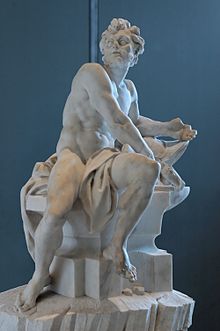 Hephaestus at the Forge by Guillaume Coustou the Younger (Louvre) Hephaestus at the Forge by Guillaume Coustou the Younger (Louvre) | |
| Abode | Mount Olympus |
| Symbol | hammer, anvil, tongs |
| Genealogy | |
| Parents | Zeus and Hera, or Hera alone |
| Siblings | Aeacus, Angelos, Aphrodite, Apollo, Ares, Artemis, Athena, Dionysus, Eileithyia, Enyo, Eris, Ersa, Hebe, Helen of Troy, Heracles, Hermes, Minos, Pandia, Persephone, Perseus, Rhadamanthus, the Graces, the Horae, the Litae, the Muses, the Moirai |
| Consort | Aphrodite, Aglaea |
| Children | Thalia, Erichthonius, Eucleia, Eupheme, Philophrosyne, Cabeiri and Euthenia |
| Equivalents | |
| Canaanite | Kothar-wa-Khasis |
| Roman | Vulcan |
| Part of a series on | ||||||||
| Ancient Greek religion | ||||||||
|---|---|---|---|---|---|---|---|---|
 | ||||||||
| Origins | ||||||||
| Sacred PlacesSacred Islands Sacred Mountains Sanctuaries Other | ||||||||
Deities
|
||||||||
ConceptsWorldview
|
||||||||
PracticesWorship
|
||||||||
| Philosophy | ||||||||
Philosophers
|
||||||||
| Texts | ||||||||
| Other Topics | ||||||||
Hephaestus (/hɪˈfiːstəs, hɪˈfɛstəs/; eight spellings; Template:Lang-grc-gre) is the Greek god of blacksmiths, metalworking, carpenters, craftsmen, artisans, sculptors, metallurgy, fire (compare, however, with Hestia), and volcanoes. Hephaestus's Roman counterpart is Vulcan. In Greek mythology, Hephaestus was either the son of Zeus and Hera or he was Hera's parthenogenous child. He was cast off Mount Olympus by his mother because of his deformity or, in another account, by Zeus for protecting Hera from his advances.
As a smithing god, Hephaestus made all the weapons of the gods in Olympus. He served as the blacksmith of the gods, and was worshipped in the manufacturing and industrial centres of Greece, particularly Athens. The cult of Hephaestus was based in Lemnos. Hephaestus's symbols are a smith's hammer, anvil, and a pair of tongs.
Etymology
Hephaestus is probably associated with the Linear B (Mycenaean Greek) inscription 𐀀𐀞𐀂𐀴𐀍, A-pa-i-ti-jo, found at Knossos. The inscription indirectly attests his worship at that time because it is believed that it reads the theophoric name (H)āpʰaistios, or Hāphaistion. The Greek theonym Hēphaistos is most likely of Pre-Greek origin, as the form without -i- (Attic Hēphastos) shows a typical Pre-Greek variation and points to an original s.
Epithets
Hephaestus is given many epithets. The meaning of each epithet is:
- Amphigýeis "the lame one" (Ἀμφιγύεις)
- Kyllopodíōn "the halting" (Κυλλοποδίων)
- Khalkeús "coppersmith" (Χαλκεύς)
- Klytotékhnēs "renowned artificer" (Κλυτοτέχνης)
- Polýmētis "shrewd, crafty" or "of many devices" (Πολύμητις)
- Aitnaîos "Aetnaean" (Αἰτναῖος), owing to his workshop being supposedly located below Mount Aetna.
Mythology
Craft of Hephaestus
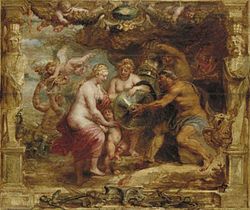
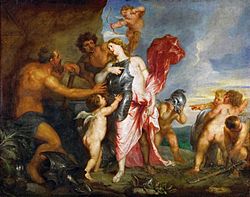
Hephaestus had his own palace on Olympus, containing his workshop with anvil and twenty bellows that worked at his bidding. Hephaestus crafted much of the magnificent equipment of the gods, and almost any finely wrought metalwork imbued with powers that appears in Greek myth is said to have been forged by Hephaestus. He designed Hermes' winged helmet and sandals, the Aegis breastplate, Aphrodite's famed girdle, Agamemnon's staff of office, Achilles' armour, Diomedes' cuirass, Heracles' bronze clappers, Helios' chariot, the shoulder of Pelops, and Eros's bow and arrows. In later accounts, Hephaestus worked with the help of the Cyclopes—among them his assistants in the forge, Brontes, Steropes and Arges.
Hephaestus built automatons of metal to work for him. This included tripods that walked to and from Mount Olympus. He gave to the blinded Orion his apprentice Cedalion as a guide. In some versions of the myth, Prometheus stole the fire that he gave to man from Hephaestus's forge. Hephaestus also created the gift that the gods gave to man, the woman Pandora and her pithos. Being a skilled blacksmith, Hephaestus created all the thrones in the Palace of Olympus.
The Greek myths and the Homeric poems sanctified in stories that Hephaestus had a special power to produce motion. He made the golden and silver lions and dogs at the entrance of the palace of Alkinoos in such a way that they could bite the invaders. The Greeks maintained in their civilization an animistic idea that statues are in some sense alive. This kind of art and the animistic belief goes back to the Minoan period, when Daedalus, the builder of the labyrinth, made images which moved of their own accord. A statue of the god was somehow the god himself, and the image on a man's tomb indicated somehow his presence.
Parentage
- According to Hesiod (Theogony, 927-928) Hera gave birth to Hephaestus on her own as revenge for Zeus giving birth to Athena without her (Zeus lay with Metis).
- According to Homer (Iliad, I 571-577) Hera is mentioned as the mother of Hephaestus but there is not sufficient evidence to say that Zeus was his father (although he refers to him in such way).
- According to Homer (Odyssey, VIII 306) there is not sufficient evidence to say that Zeus was the father of Hephaestus (although he refers to him in such way). Hera is not mentioned as the mother.
- According to Pseudo-Apollodorus (Bibliotheca, 1.3.6) Hera gave birth to Hephaestus alone. Pseudo-Apollodorus also relates that, according to Homer, Hephaestus is one of the children of Zeus and Hera (consciously contradicting Hesiod and Homer).
- Several later texts follow Hesiod's account, including Hyginus and the preface to Fabulae.
In the account of Attic vase painters, Hephaestus was present at the birth of Athena and wields the axe with which he split Zeus' head to free her. In the latter account, Hephaestus is there represented as older than Athena, so the mythology of Hephaestus is inconsistent in this respect.
Fall from Olympus
In one branch of Greek mythology, Hera ejected Hephaestus from the heavens because he was "shrivelled of foot". He fell into the ocean and was raised by Thetis (mother of Achilles and one of the 50 Nereids) and the Oceanid Eurynome.
In another account, Hephaestus, attempting to rescue his mother from Zeus' advances, was flung down from the heavens by Zeus. He fell for an entire day and landed on the island of Lemnos, where he was cared for and taught to be a master craftsman by the Sintians – an ancient tribe native to that island. Later writers describe his lameness as the consequence of his second fall, while Homer makes him lame and weak from his birth.
Return to Olympus
Hephaestus was one of the Olympians to have returned to Olympus after being exiled.
In an archaic story, Hephaestus gained revenge against Hera for rejecting him by making her a magical golden throne, which, when she sat on it, did not allow her to stand up. The other gods begged Hephaestus to return to Olympus to let her go, but he refused, saying "I have no mother".

At last, Dionysus fetched him, intoxicated him with wine, and took the subdued smith back to Olympus on the back of a mule accompanied by revelers – a scene that sometimes appears on painted pottery of Attica and of Corinth. In the painted scenes, the padded dancers and phallic figures of the Dionysan throng leading the mule show that the procession was a part of the dithyrambic celebrations that were the forerunners of the satyr plays of fifth century Athens.
The theme of the return of Hephaestus, popular among the Attic vase-painters whose wares were favored among the Etruscans, may have introduced this theme to Etruria. In the vase-painters' portrayal of the procession, Hephaestus was mounted on a mule or a horse, with Dionysus holding the bridle and carrying Hephaestus' tools (including a double-headed axe).
The traveller Pausanias reported seeing a painting in the temple of Dionysus in Athens, which had been built in the 5th century but may have been decorated at any time before the 2nd century CE. When Pausanias saw it, he said:
There are paintings here – Dionysus bringing Hephaestus up to heaven. One of the Greek legends is that Hephaestus, when he was born, was thrown down by Hera. In revenge he sent as a gift a golden chair with invisible fetters. When Hera sat down she was held fast, and Hephaestus refused to listen to any other of the gods except Dionysus – in him he reposed the fullest trust – and after making him drunk Dionysus brought him to heaven.
— Pausanias, 1.20.3
Consorts and children
According to most versions, Hephaestus's consort is Aphrodite, who is unfaithful to Hephaestus with a number of gods and mortals, including Ares. However, in Book XVIII of Homer's Iliad, the consort of Hephaestus is a lesser Aphrodite, Charis ("the grace") or Aglaia ("the glorious") – the youngest of the Graces, as Hesiod calls her.
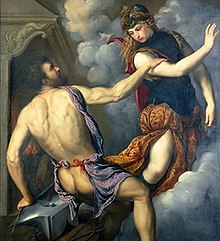
In Athens, there is a Temple of Hephaestus, the Hephaesteum (miscalled the "Theseum") near the agora. An Athenian founding myth tells that the city's patron goddess, Athena, refused a union with Hephaestus. Pseudo-Apollodorus records an archaic legend, which claims that Hephaestus once attempted to rape Athena, but she pushed him away, causing him to ejaculate on her thigh. Athena wiped the semen off using a tuft of wool, which she tossed into the dust, impregnating Gaia and causing her to give birth to Erichthonius, whom Athena adopted as her own child. The Roman mythographer Hyginus records a similar story in which Hephaestus demanded Zeus to let him marry Athena since he was the one who had smashed open Zeus's skull, allowing Athena to be born. Zeus agreed to this and Hephaestus and Athena were married, but, when Hephaestus was about to consummate the union, Athena vanished from the bridal bed, causing him to ejaculate on the floor, thus impregnating Gaia with Erichthonius.
On the island of Lemnos, Hephaestus' consort was the sea nymph Cabeiro, by whom he was the father of two metalworking gods named the Cabeiri. In Sicily, his consort was the nymph Aetna, and his sons were two gods of Sicilian geysers called Palici. With Thalia, Hephaestus was sometimes considered the father of the Palici.
Hephaestus fathered several children with mortals and immortals alike. One of those children was the robber Periphetes.
This is the full list of his consorts and children according to the various accounts:
- Aphrodite
- Aglaea
- Aetna
- The Palici
- Cabeiro
- The Cabeiri
- The Cabeirian nymphs
- Gaia
- Anticleia
- by unknown mothers
- Ardalus
- Cercyon (possibly)
- Olenus
- Palaemonius, Argonauts
- Philottus
- Pylius (Πύλιος), he cured the hero Philoktetes at Lemnos.
- Spinter
In addition, the Romans claim their equivalent god, Vulcan, to have produced the following children:
Hephaestus and Aphrodite
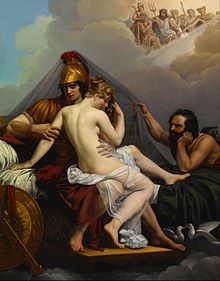
Though married to Hephaestus, Aphrodite had an affair with Ares, the god of war. Eventually, Hephaestus discovered Aphrodite's affair through Helios, the all-seeing Sun, and planned a trap during one of their trysts. While Aphrodite and Ares lay together in bed, Hephaestus ensnared them in an unbreakable chain-link net so small as to be invisible and dragged them to Mount Olympus to shame them in front of the other gods for retribution.
The gods laughed at the sight of these naked lovers, and Poseidon persuaded Hephaestus to free them in return for a guarantee that Ares would pay the adulterer's fine or that he would pay it himself. Hephaestus states in The Odyssey that he would return Aphrodite to her father and demand back his bride price. The Emily Wilson translation depicts Hephaestus demanding/imploring Zeus before Poseidon offers, however, leading the reader to assume Zeus did not give back the "price" Hephaestus paid for "his daughter " and was thus why Poseidon intervened. Some versions of the myth state that Zeus did not return the dowry, and in fact Aphrodite "simply charmed her way back again into her husband’s good graces."
The Thebans told that the union of Ares and Aphrodite produced Harmonia. However, of the union of Hephaestus with Aphrodite, there was no issue unless Virgil was serious when he said that Eros was their child. Later authors explain this statement by saying that Eros was sired by Ares but passed off to Hephaestus as his own son.
Hephaestus was somehow connected with the archaic, pre-Greek Phrygian and Thracian mystery cult of the Kabeiroi, who were also called the Hephaistoi, "the Hephaestus-men", in Lemnos. One of the three Lemnian tribes also called themselves Hephaestion and claimed direct descent from the god.
Hephaestus and Athena
Hephaestus is to the male gods as Athena is to the females, for he gives skill to mortal artists and was believed to have taught men the arts alongside Athena. He was nevertheless believed to be far inferior to the sublime character of Athena. At Athens they had temples and festivals in common. Both were believed to have great healing powers, and Lemnian earth (terra Lemnia) from the spot on which Hephaestus had fallen was believed to cure madness, the bites of snakes, and haemorrhage, and priests of Hephaestus knew how to cure wounds inflicted by snakes.
He was represented in the temple of Athena Chalcioecus (Athena of the Bronze House) at Sparta, in the act of delivering his mother; on the chest of Cypselus, giving Achilles's armour to Thetis; and at Athens there was the famous statue of Hephaestus by Alcamenes, in which his lameness was only subtly portrayed. He had almost "no cults except in Athens" and was possibly seen as a more approachable god to the city which shared her namesake. The Greeks frequently placed small dwarf-like statues of Hephaestus near their hearths, and these figures are the oldest of all his representations. During the best period of Grecian art he was represented as a vigorous man with a beard, and is characterized by his hammer or some other crafting tool, his oval cap, and the chiton.
Athena is sometimes thought to be the "soulmate" of Hephaestus. Nonetheless, he "seeks impetuously and passionately to make love to Athena: at the moment of climax she pushes him aside, and his semen falls to the earth where it impregnates Gaia."
Volcano god
Some state that his origin myth was that of a "daemon of fire coming up from the earth" -- that he was also associated with gas "which takes fire and burns is considered by many people to be divine" and that only later was a volcano considered Hephaestus's smithy.
Hephaestus was associated by Greek colonists in southern Italy with the volcano gods Adranus (of Mount Etna) and Vulcanus of the Lipari islands. The first-century sage Apollonius of Tyana is said to have observed, "there are many other mountains all over the earth that are on fire, and yet we should never be done with it if we assigned to them giants and gods like Hephaestus".
Nevertheless, Hephaestus’ domain over fire goes back to Homer’s Iliad, where he uses flames to dry the waters of Scamandrus river and force its homonym deity, who was attacking Achilles, to retreat.
Other mythology
In the Trojan war, Hephaestus sided with the Greeks, but was also worshiped by the Trojans and saved one of their men from being killed by Diomedes. Hephaestus' favourite place in the mortal world was the island of Lemnos, where he liked to dwell among the Sintians, but he also frequented other volcanic islands such as Lipara, Hiera, Imbros and Sicily, which were called his abodes or workshops.
The epithets and surnames by which Hephaestus is known by the poets generally allude to his skill in the plastic arts or to his figure or lameness. The Greeks frequently placed small dwarf-like statues of Hephaestus near their hearths, and these figures are the oldest of all his representations.
At the marriage of Peleus and Thetis he gave a knife as a wedding present.
Symbolism
Hephaestus was sometimes portrayed as a vigorous man with a beard and was characterized by his hammer or some other crafting tool, his oval cap, and the chiton.
Hephaestus is described in mythological sources as "lame" (chōlos), and "halting" (ēpedanos). He was depicted with crippled feet and as misshapen, either from birth or as a result of his fall from Olympus. In vase paintings, Hephaestus is usually shown lame and bent over his anvil, hard at work on a metal creation, and sometimes with his feet back-to-front: Hephaistos amphigyēeis. He walked with the aid of a stick. The Argonaut Palaimonius, "son of Hephaestus" (i.e. a bronze-smith) was also lame.
Other "sons of Hephaestus" were the Cabeiri on the island of Samothrace, who were identified with the crab (karkinos) by the lexicographer Hesychius. The adjective karkinopous ("crab-footed") signified "lame", according to Detienne and Vernant. The Cabeiri were also lame.
In some myths, Hephaestus built himself a "wheeled chair" or chariot with which to move around, thus helping him overcome his lameness while demonstrating his skill to the other gods. In the Iliad 18.371, it is stated that Hephaestus built twenty bronze wheeled tripods to assist him in moving around.
Hephaestus's misshapen appearance and lameness are taken by some to represent peripheral neuropathy and skin cancer resulting from arsenicosis caused by arsenic exposure from metalworking. Bronze Age smiths added arsenic to copper to produce harder arsenical bronze, especially during periods of tin scarcity. Many Bronze Age smiths would have suffered from chronic arsenic poisoning as a result of their livelihood. Consequently, the mythic image of the lame smith is widespread. As Hephaestus was an iron-age smith, not a bronze-age smith, the connection is one from ancient folk memory.
Comparative mythology
Parallels in other mythological systems for Hephaestus's symbolism include:
- The Ugarit craftsman-god Kothar-wa-Khasis, who is identified from afar by his distinctive walk – possibly suggesting that he limps.
- As Herodotus was given to understand, the Egyptian craftsman-god Ptah was a dwarf, naked, and deformed.
- In Norse mythology, Weyland the Smith was a lame bronzeworker.
- In Hinduism the artificer god Tvastr fills a similar role, albeit more positively portrayed.
- The Ossetian god Kurdalagon may share a similar origin.
Cities and places
Solinus wrote that the Lycians dedicated a city to Hephaestus and called it Hephaestia. The Hephaestia in Lemnos was named after the god. In addition, the whole island of Lemnos was sacred to Hephaestus.
Pausanias wrote that the Lycians in Patara had a bronze bowl in their temple of Apollo, saying that Telephus dedicated it and Hephaestus made it.
The island Thermessa, between Lipari and Sicily was also called Hiera of Hephaestus (ἱερὰ Ἡφαίστου), meaning sacred place of Hephaestus in Greek.
Minor planet
The minor planet 2212 Hephaistos discovered in 1978 by Soviet astronomer Lyudmila Chernykh was named in Hephaestus' honour.
Sooty grunter
The sooty grunter (Hephaestus fuliginosus), a dark, typically sooty-coloured freshwater fish of the family Terapontidae found in northern Australia, is named after Hephaestus.
Stones
Pliny the Elder wrote that at Corycus there was a stone which was called Hephaestitis or Hephaestus stone. According to Pliny, the stone was red and was reflecting images like a mirror, and when boiling water poured over it cooled immediately or alternatively when it placed in the sun it immediately set fire to a parched substance.
See also
Notes
- Features within the narrative suggest to Kerenyi and others that it is archaic; the most complete literary account, however, is a late one, in the Roman rhetorician Libanios, according to Hedreen (2004).
- A section "The Binding of Hera" is devoted to this archaic theme in Kerenyi (1951, pp 156–158), who refers to this "ancient story", which is one of the "tales of guileful deeds performed by cunning gods, mostly at a time when they had not joined the family on Olympus".
- The return of Hephaestus was painted on the Etruscan tomb at the "Grotta Campana" near Veii was identified by Petersen (1902); the "well-known subject" was doubted in this instance by Harmon (1912).
- See Dict of Ant. s. v. Hêphaisteia, Chalkeia.
References
Citations
- "Kothar". Britannica.
- ^ Walter Burkert, Greek Religion 1985: III.2.ii; see coverage of Lemnos-based traditions and legends at Mythic Lemnos
- Graves, Robert (1955). The Greek Myths: 1. Harmondsworth, Middlesex, England: Penguin Books. p. 51. ISBN 0736621121.
- ^ Homeric Hymn to Apollo 316–321; Homer, Iliad 395–405.
- ^ Homer, Iliad 1.590–594; Valerius Flaccus, ii, 8.5; Apollodorus, i, 3 § 5. Apollodorus confounds the two occasions on which Hephaestus was thrown from Olympus.
- ^ Beekes 2009, p. 527.
- Chadwick, John (1976). The Mycenaean World. Cambridge, UK: Cambridge University Press. pp. 99. ISBN 0-521-29037-6. At Google Books.
- Anthology of Classical Myth: Primary Sources in translation. Hackett Publishing. 2004. p. 443. ISBN 0-87220-721-8. At Google Books
- Autenrieth, Georg (1891). "Hephaestus". A Homeric Dictionary for Schools and Colleges. United States of America: Harper and Brothers.
- Aelian, Hist. An. xi. 3, referenced under Aetnaeus in William Smith's Dictionary of Greek and Roman Biography and Mythology
- Il. xviii. 370, &c.
- The provenance of the staff of office is recounted in Iliad II
- ^ Graves, Robert (1960). "The Palace of Olympus". Greek Gods and Heroes. United States of America: Dell Laurel-Leaf. p. 150.
- Virg. Aen. viii. 416, &c.
- West (1979). "The Prometheus Trilogy. The Journal of Hellenic Studies" (99): 130–148.
{{cite journal}}: Cite journal requires|journal=(help) - Iliad, XVIII 372ff
- Iliad, VIII: Nigel Spivey (1997): The Greek art. Phaidon Press Limited, p.9
- Diodorus Siculus, LV 76
- C.M.Bowra (1957).The Greek experience. The World Publishing company. p.159
- Guy Hedreen (2004) The Return of Hephaistos, Dionysiac Processional Ritual and the Creation of a Visual Narrative. The Journal of Hellenic Studies, 124 (2004:38–64) p. 38 and note.
- ^ Kerényi 1951, p. 156–158.
- Axel Seeberg (1965) Hephaistos Rides Again. The Journal of Hellenic Studies, 85, pp. 102–109, describes and illustrates four pieces of Corinthian painted pottery with the theme
- A black red-figure calpis in the collection of Marsden J. Perry was painted with the return of Hephaestus (Eldridge, 1917, pp 38–54).
- L. G. Eldridge (1917) An Unpublished Calpis. American Journal of Archaeology, 21.1, pp 38–54 (January–March 1917).
- The significance of the subject for the pre-history of Greek drama is argued by Webster (1958, pp 43ff.) and more recently by Hedreen (2004, pp 38–64).
- T.B.L. Webster (1958) Some thoughts on the pre-history of Greek drama. Bulletin of the Institute of Classical Studies, 5, pp 43ff.
- Petersen (1902) Über die älteste etruskische Wandmälerei, pp 149ff.. Rome.
- A. M. Harmon (1912) The Paintings of the Grotta Campana. American Journal of Archaeology, 16.1, 1–10 (January–March 1912);
- Hesiod, Theogony, 945
- ^ Kerényi 1951, p. 281.
- ^ Kerényi 1951, p. 123.
- ^ Burkert, Walter (1985), Greek Religion, Cambridge, Massachusetts: Harvard University Press, p. 143, ISBN 0-674-36281-0
- Hyginus made an imaginative etymology for Erichthonius, of strife (Eris) between Athena and Hephaestus and the Earth-child (chthonios).
- Strabo, 10.3.21 citing Pherecydes.
- ^ Photius, Bibliotheca excerpts - GR
- Photius, Bibliotheca excerpts, 190.48 - EN
- Plutarch, Of Love, Moralia, 18
- Wilson, Emily (7 November 2017). The Odyssey. W. W. Norton. pp. BOOK 4, LINES 265-367. ISBN 9780393634563.
- Richardson, Donald (1984). Great Zeus and All His Children. Prentice-Hall. ISBN 9780133649505.
- Aeneid i.664
- Od. vi. 233, xxiii. 160. Hymn. in Vaulc. 2. &c.
- Philostr. Heroic. v. 2; Eustath. ad Hom. p. 330; Dict. Cret. ii. 14.
- The Museum of Goddess Athena, Sanctuary of Athena Chalkiokos at Sparta
- Paus. iii. 17. § 3
- v. 19. § 2
- Cic. de Nat. Deor. i. 30; Val. Max. viii. 11. § 3
- Nilsson ·, Martin Persson (1998). Greek Folk Religion. University of Pennsylvania Press. p. 89. Retrieved 26 March 2021.
- Herod. iii. 37; Aristoph. Av. 436; Callim. Hymnn. in Dian. 60
- Stein, p. 11, which goes on to say: "Yet a kind of cloudy mysteriousness shrouds their relationship; no single tradition was ever clearly established on this subject, and so what confronts us is a blurred image based on rumors and conflicting reports."
- Hillman, James (1980). Facing the Gods. Spring Pubns. ISBN 978-0882143125.
- Nilsson ·, Martin Persson (1998). Greek Folk Religion. University of Pennsylvania Press. p. 89. Retrieved 26 March 2021.
- Life of Apollonius of Tyana, book v.16.
- Homer, Iliad, v, 9ff.
- Od. viii. 283ff.
- Homer, Iliad, i, 593.
- Ovid, Fasti, viii, 82.
- Apollonius of Rhodes, iii. 41.
- Callimachus, Hymn. in Dian. 47
- Serv. ad Aen, viii, 416.
- Strabo, p. 275.
- Pliny, Naturalis Historia, iii, 9.
- Valerius Flaccus, ii, 96.
- Heroditus, iii, 37
- Aristophanes, Av., 436.
- Callimachus, Hymn. in Dian., 60.
- Photius, Bibliotheca excerpts, 190.46 - EN
- Odyssey 8.308; Iliad 18.397, etc.
- Apollonius of Rhodes, Argonautica i.204.
- Detienne, Marcel; Vernant, Jean-Pierre (1978). Cunning Intelligence in Greek Culture and Society. Janet Lloyd, translator. Atlantic Highlands, NJ: Humanities Press. pp. 269–272. ISBN 978-0-391-00740-6. Cited by Silver, Morris (1992). Taking Ancient Mythology Economically. New York: Brill. p. 35 note 5. ISBN 978-90-04-09706-3.
- Dolmage, Jay (2006). "'Breathe Upon Us an Even Flame': Hephaestus, History, and the Body of Rhetoric". Rhetoric Review. 25 (2): 119–140 . doi:10.1207/s15327981rr2502_1. S2CID 17273927.
- Murray, A.T. "The Iliad 18.371". Perseus. Tufts University. Retrieved 21 March 2017.
- Harper, M (October 1987). "Possible toxic metal exposure of prehistoric bronze workers". British Journal of Industrial Medicine. 44 (10): 652–656. doi:10.1136/oem.44.10.652. ISSN 0007-1072. PMC 1007896. PMID 3314977.
- Saggs, H. W. F. (1989). Civilization Before Greece and Rome. New Haven: Yale University Press. pp. 200–201. ISBN 978-0-300-04440-9.
- Baruch Margalit, Aqhat Epic 1989:289.
- Herodotus, iii.36.
- ^ West, Martin Litchfield (2007), Indo-European Poetry and Myth, Oxford, England: Oxford University Press, ISBN 978-0-19-928075-9
- Solinus, Polyhistor, 39.1
- Dionysius of Alexandria, Guide to the Inhabited World, 520
- Pausanias, Description of Greece, 9.41.1
- Strabo, Geography, 6.2.10
- Schmadel, Lutz D. (2003). Dictionary of Minor Planet Names (5th ed.). New York: Springer Verlag. p. 180. ISBN 3-540-00238-3.
- Pliny the Elder, Natural History, 37, LX
Bibliography
- Beekes, Robert S. P. (2009). Etymological Dictionary of Greek. Brill. ISBN 978-90-04-32186-1.
- Kerényi, Karl (1951). The Gods of the Greeks. London: Thames and Hudson. ISBN 0-500-27048-1.
- Stein, Murray, Soul: Treatment and Recovery: The selected works of Murray Stein, Routledge, 2015. ISBN 9781317649847.
- Strabo, Geography, translated by Horace Leonard Jones; Cambridge, Massachusetts: Harvard University Press; London: William Heinemann, Ltd. (1924). LacusCurtis, Online version at the Perseus Digital Library, Books 6–14.
External links
- Theoi Project, Hephaestus in classical literature and art
- Greek Mythology Link, Hephaestus summary of the myths of Hephaestus
| Greek deities series | |||||
|---|---|---|---|---|---|
| |||||